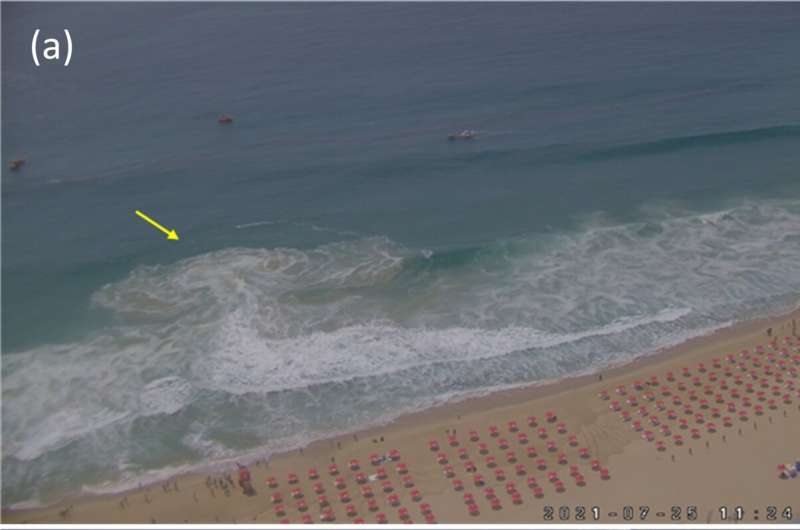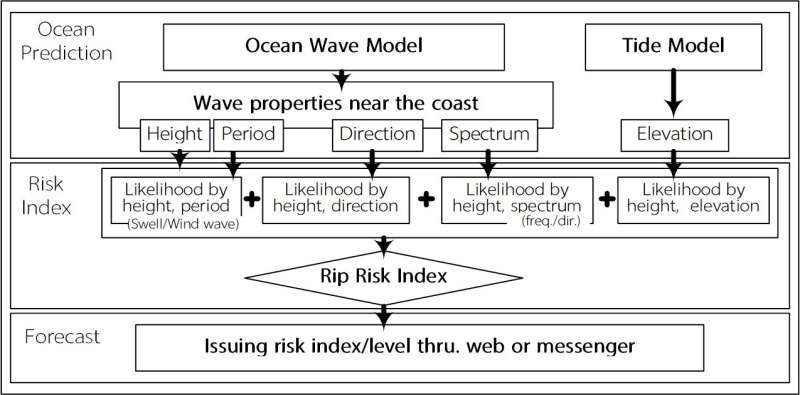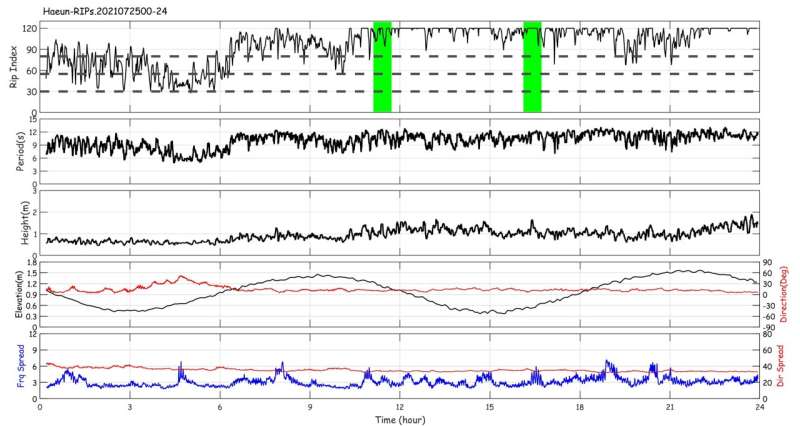Snapshots of rip current events at 11:25 and 16:25(KST), the 25th of July, 2021 at the Haeundae beach. Credit: Korea Water Resources Association
Rip currents are a serious threat to beachgoers at any coast around the world. There are reported number of fatalities caused by rip currents every year in the U.S. and Australia. According to Surf Lifesaving Australia, rip currents were responsible for at least 21 drowning deaths per year.
Historically, it has been difficult to measure rip currents that are mostly invisible and random in time and location. And its prediction involves limitations due to weather and ocean forecasts as well as the rip current model. In other words, it is difficult to predict its location as well as its occurrence, especially for transient rip currents, so-called flash rips that can be observed in directional random wave environments. Therefore, the prediction of rip currents is still an ongoing issue in the ocean forecasting field.
The Korea Institute of Civil Engineering and Building Technology (KICT) has announced a new approach for predicting the rip currents. A research team, led by Dr. Junwoo Choi of Department of Hydro Science and Engineering Research, developed a new prediction system which has already been tested at ten beaches in South Korea. Ten beaches including Haeundae beach in Busan, showed higher than 80% of accuracy rate. No fatality has been reported at the beaches during its operation.
The advanced rip-current prediction system implementing the new approach produces a sequence of rip-current risk index at a specific coast. The prediction system can be operated with an ocean observation system or an ocean forecasting system to support the time-varying inputs of wave height, wave period, wave direction, spectral spreading, and tidal elevation.
-
The procedure to compute the risk index in the rips prediction system with a ocean forecast model. Credit: Korea Water Resoureces Association
-
Time series of rip-current index and observations of the 25th of July, 2021 at the Haeundae beach. Credit: Korea Water Resoureces Association
The rip-current risk index is computed by a function of the rip-current likelihoods varied according to the six parameters which are established by utilizing in-advance numerical simulations of rip currents at each individual coast. Note that the six parameters are the input conditions of the wave-current model, FUNWAVE (published by Univ. of Delaware) that was employed because it can solve flash rips induced by phase-resolving directional random waves.
The performance of the present approach has been checked by operating the rip-current prediction system with a real-time ocean observation system at ten popular beaches in South Korea. Dr. Junwoo Choi said, "The needs of a rip-current prediction system is clear and explicit, and the risk index can help lifeguards and save swimmers in the coast covered by the present rip-current system."
The study (in Korean) is published in the Journal of Korea Water Resources Association.
More information: Junwoo Choi, A modification of the rip current warning system utilizing real-time observations: a database function of likelihood distributions, Journal of Korea Water Resources Association (2022). DOI: 10.3741/JKWRA.2022.55.10.843. jkwra.or.kr/articles/article/aKWm/#Information
Provided by National Research Council of Science & Technology


























